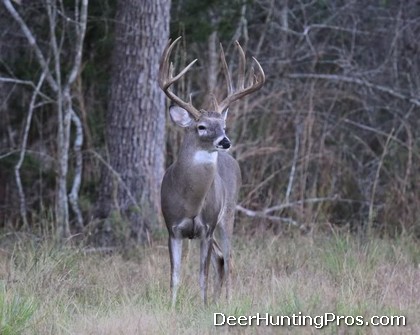In some ways, there is no limit when it comes to whitetail deer hunting. Yes, there are bag limits, but hunters are not limited in what they can do to make there property more attractive to deer. Hunting success is often linked with prior planning, or more specifically, deer management activities. But habitat manipulation must go hand-in-hand with well-planned deer hunting tactics, otherwise each is sunk. Questions are commonly asked of us about deer hunting small acreage. Many hunters are faced with making small tracts productive hunting lands. This is because land is expensive. Most hunters do not own or have access to a lot of it.
The general goal with deer hunting small acreage is to enhance and manage for all the components whitetail deer require. These include food, cover, water and some amount of space for security. The most important aspect of smaller hunting tracts is that it must be developed not only for deer, but also specifically for deer hunting. Not only should the deer be able to move on to and off the property safely, but the person hunting the land needs to have a number of corridors to access hunting locations. In fact, having the option between several hunting stand locations is the key.
Large properties offer whitetail deer security in that they simply do not see a lot of human activity. This can be more difficult on small properties. So how can you attract and hold deer on small acreage? Providing high quality foods is a must, but during the season it will be hunting pressure that is the most critical factor when deer hunting on small acreage. Stay low profile! It is important to hunt small on small acreage.

Before we get too far into this, I see that I forgot something important. So what would be classified as small acreage? Well, I would say anything from 300 acres on down would definitely fit into that category. A whole lot of deer hunting activity takes place on properties ranging from only 20 to 50 acres in size, so those obviously fit into the small acreage classification. Properties that are less than 10 acres in size would likely be classified as micro-acreage. They can offer deer hunting success, but hunters must make sure they do it the right way, right from the start.
Habitat is important. Habitat is comprised of the plants deer eat and the ones they need for cover. The habitat on any property will depend on what the soils and topography allows. The biggest advantage that small properties have over larger ones is that they can be micro-managed. Beneficial plants can be planted, seeded or manipulated specifically for whitetail. To really make a property attractive to whitetail deer, to really make it stand out, small acreage hunters should strive to offer deer the most limited resource found in the area. In short, if cover is sparse, grow it. If high quality foods or crops are lacking, establish a fall food plot that is adapted to the area. Plant a spring food plot for that matter, too.
During the hunting season make sure you hunt the travel routes to and from the food plot, not directly on the food plot itself, especially if you are bow hunting. Most hunters want to sit right on the food plot. This can work if the wind conditions are right, but not always. In fact, it’s easier to catch deer before they get to the plot, where they get a bit more cautious. Set a stand down wind of their trail and the deer will always be upwind of you.
When it comes to deer hunting small acreage, the biggest factor from the deer’s perspective is hunting pressure. Deer figure out pretty fast which areas are safe and which ones are not. Deer quickly change their behavior during the hunting season based on what they see and smell. The key to successfully hunting small acreage is to once again, stay low profile! Plan your habitat management activities as well as your hunting activities.
It is very easy for whitetail avoid small acreages. Do not give them a reason. The best way to avoid having deer avoid your property is to make sure your stands are setup correctly, and that you have several stands to choose from. When you head out deer hunting you can choose the one that is right for the day’s wind conditions. Also pay attention to how you move to and from these stands to avoid pushing deer out of the area. The most difficult thing you can do is stay out the woods on days when wind conditions are unfavorable. Always avoid alerting the deer in and around the property.
Deer tend to be/go where the hunters are not. The trick is to never be there, or at least as far as the deer know. Deer hunting small acreages successfully is about providing for the needs of the whitetail deer in your area as well as making it appear that there is zero hunting pressure. Make sure the small property you are hunting has good travel corridors, for both you and the deer, that you strive to provide them with items not found or in limited availability on other lands, and that you hunt only during the times when the winds are in your favor.